Alien angels or celestial messengers? Explore the intriguing connection between Pleiadians and biblical scripture, unraveling cosmic mysteries hidden within ancient texts.
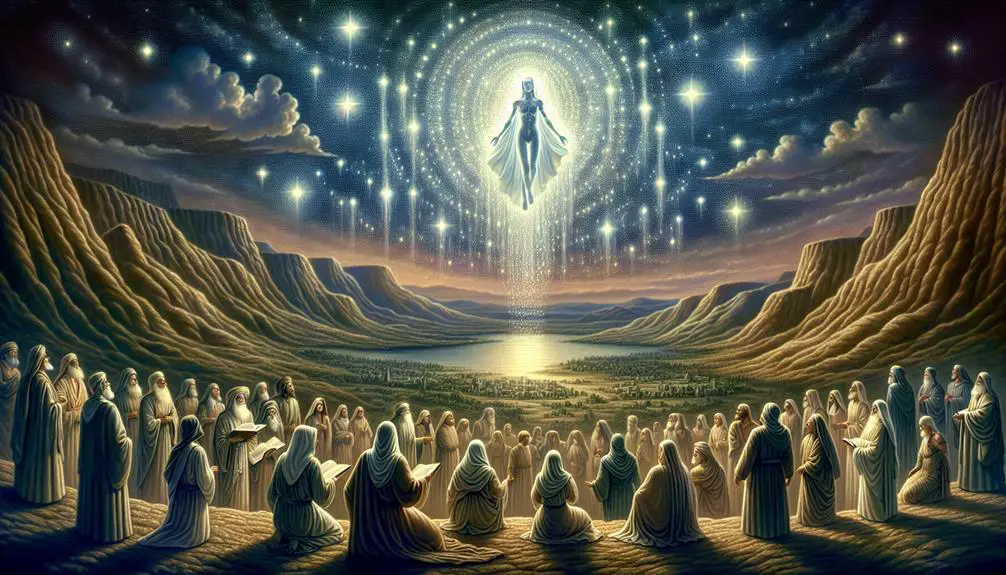
Pleiadians in the Bible
The intersection of biblical scripture and extraterrestrial theories presents a fascinating tableau, particularly when considering the enigmatic Pleiadians. Within the sacred texts, passages that have traditionally been interpreted to reference angels or divine messengers may, upon closer inspection, hold clues to a more cosmic connection.
The Book of Enoch, often cited by proponents of the ancient astronaut theory, serves as a pivotal text in this discourse, suggesting a celestial lineage that intersects with human history. This exploration not only challenges conventional interpretations but also invites a broader contemplation of our place within the universe.
How might our understanding of spiritual texts transform if we consider the possibility of interstellar origins?
Key Takeaways
- The Book of Enoch links Pleiadians to biblical narratives, challenging traditional interpretations.
- Job 38:31 and Amos 5:8 suggest biblical verses carry cosmic meanings, hinting at Pleiadian connections.
- Ancient astronaut theories reevaluate biblical stories as potential encounters with extraterrestrial beings, including Pleiadians.
- Cultural and historical contexts reveal a global recognition of the Pleiades, influencing perceptions of celestial phenomena in biblical texts.
The Pleiadian Connection Explored
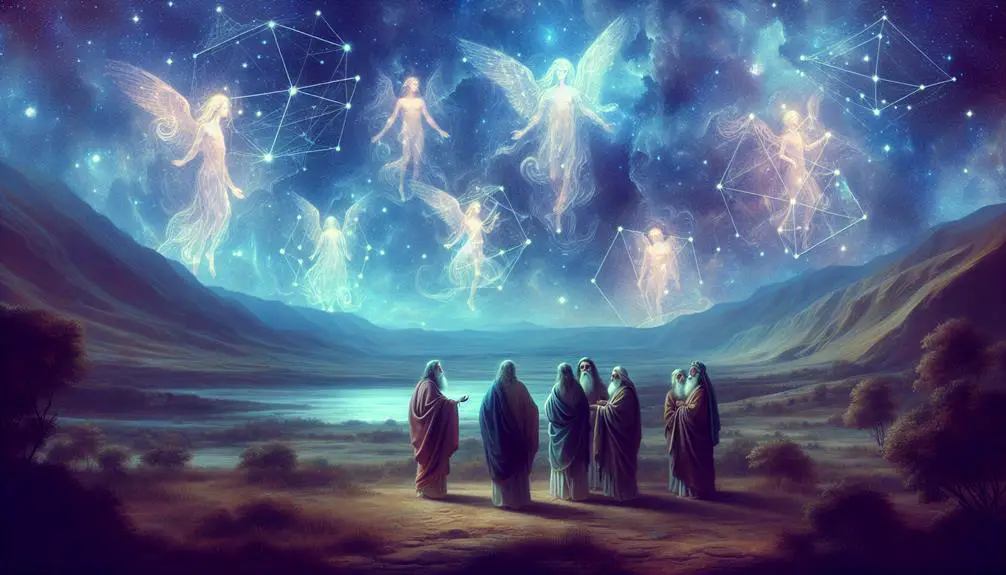
In examining the purported Pleiadian connection within biblical texts, it becomes essential to approach the subject with a critical yet open-minded analysis, dissecting the intersections between ancient scriptures and contemporary extraterrestrial theories. This investigation delves into the realm of stellar myths and cultural perceptions, shedding light on how these narratives have shaped human understanding of the cosmos and its potential inhabitants.
Stellar myths have long served as a bridge between the earthly and the divine, with various cultures interpreting the stars as the homes of gods or ancestors. The Pleiades, a prominent cluster in the night sky, is no exception. It has captivated the imagination of societies worldwide, embedding itself into their lore and spiritual beliefs. This widespread recognition across cultures raises intriguing questions about the collective human experience and its relationship with the cosmos.
Cultural perceptions of celestial phenomena have evolved significantly over millennia, influenced by advancements in astronomy and shifts in societal values. However, the fascination with the Pleiades and their potential connection to divine or extraterrestrial beings persists, finding new expressions in modern theories that suggest a Pleiadian presence in ancient times. Such theories often draw on biblical texts, interpreting them through the lens of contemporary UFOlogy and alien mythology.
This analytical journey requires a careful consideration of the sources, weighing the historical and cultural contexts against the speculative nature of extraterrestrial hypotheses. By exploring the Pleiadian connection from this multifaceted perspective, one can better appreciate the complexity of human interaction with the stars and the enduring quest to understand our place in the universe.
Biblical Verses: A Cosmic Interpretation

Several biblical verses, when viewed through the lens of cosmic interpretation, offer intriguing possibilities of Pleiadian influence, reflecting a profound connection between ancient texts and celestial phenomena. This perspective encourages a reevaluation of scripture, transforming familiar narratives into cosmic parables rich with galactic metaphors. Such an analysis does not detract from the spiritual essence of these texts but rather expands their interpretative horizons, suggesting a multidimensional understanding of divine communication.
The table below highlights specific verses and their potential cosmic interpretations, emphasizing the interplay between celestial imagery and spiritual teachings:
Biblical Verse |
Cosmic Interpretation |
|---|---|
Job 38:31 |
"Canst thou bind the sweet influences of Pleiades?" This verse has been interpreted as a direct reference to the Pleiades star cluster, suggesting an awareness of its unique significance in the cosmos. |
Amos 5:8 |
"Seek him that maketh the Pleiades and Orion." This passage implies a creator who crafts constellations, hinting at divine craftsmanship on a galactic scale. |
Psalm 19:1 |
"The heavens declare the glory of God; the skies proclaim the work of his hands." Here, the heavens are seen as a testament to divine glory, potentially encompassing the vastness of the universe and its celestial bodies. |
Genesis 1:14 |
"Let there be lights in the vault of the sky to separate the day from the night." This could be viewed as a cosmic parable, with celestial bodies serving symbolic roles in the narrative of creation. |
Through this lens, biblical texts emerge as a tapestry woven with threads of cosmic wisdom, offering insights into the interconnection between the divine and the universe. This approach not only enriches our understanding of scripture but also aligns with a broader quest for meaning in the vastness of the cosmos.
Ancient Astronaut Theory and Scripture

The Ancient Astronaut Theory posits that scriptural texts may encapsulate encounters with extraterrestrial beings, suggesting a profound reevaluation of biblical narratives and figures.
This perspective invites an analytical examination of the possibility that certain biblical events and entities could have origins or influences not of this Earth.
It necessitates a scholarly approach to scripture, viewing ancient texts through the lens of potential interactions with advanced civilizations, thus reimagining the context of divine encounters.
Scriptural Beings' Extraterrestrial Origins
Exploring the Ancient Astronaut Theory reveals a fascinating perspective on scriptural beings, suggesting possible extraterrestrial origins within the texts of the Bible. This theory intertwines with alien religions and cosmic mythologies, offering an alternative lens through which to view biblical narratives.
In analyzing scriptural beings from an extraterrestrial viewpoint, consider:
- The depiction of angels as messengers or visitors could align with the concept of alien emissaries.
- Descriptions of divine chariots and fiery wheels in texts might hint at advanced technology rather than purely spiritual phenomena.
- The concept of God or gods walking among humans could reflect encounters with higher beings from other worlds.
- Visions and prophecies within scripture may be interpreted as transmissions or guidance from a cosmic intelligence.
This analysis invites a reevaluation of ancient texts, blending spirituality with the possibility of extraterrestrial interaction.
Biblical Events: Alien Influence
Building on the foundation of scriptural beings' possible extraterrestrial origins, this section examines specific biblical events through the lens of the Ancient Astronaut Theory, highlighting potential alien influences within these narratives. This analytical approach respects historical accuracy and scientific skepticism, fostering an open-minded exploration of scripture.
Biblical Event |
Ancient Astronaut Theory Interpretation |
Scientific Skepticism |
|---|---|---|
Parting of the Red Sea |
Advanced technology manipulation of natural elements |
Natural phenomena explanation |
Ezekiel's Wheel |
Described as a spacecraft or otherworldly vehicle |
Symbolic or visionary experience |
Tower of Babel |
Alien intervention to confuse languages |
Sociocultural development |
Sodom and Gomorrah |
Extraterrestrial weaponry causing destruction |
Geological event |
This table is designed to create imagery in the audience's mind, juxtaposing traditional interpretations with those offered by the Ancient Astronaut Theory.
The Book of Enoch: Celestial Clues
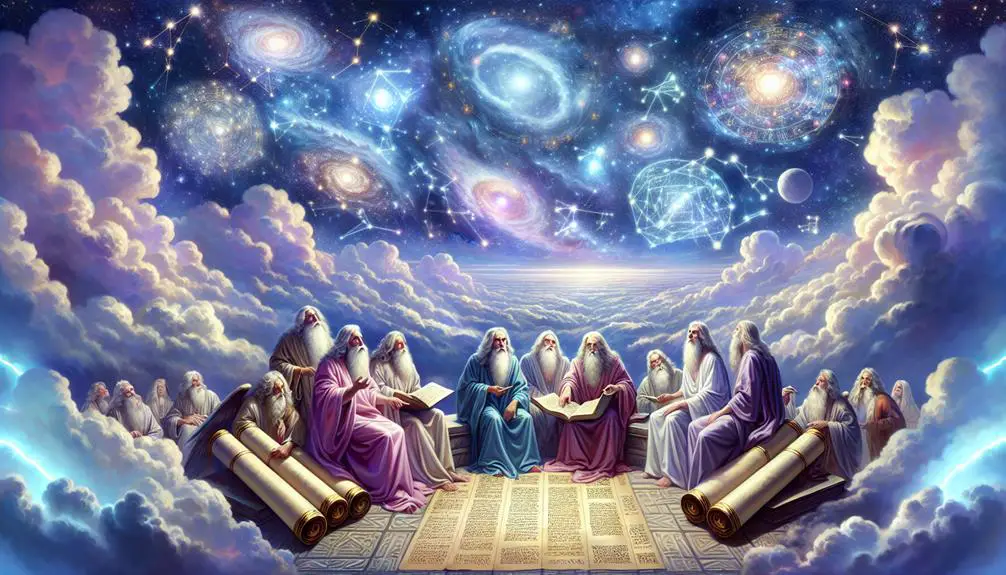
The Book of Enoch, an ancient Jewish religious work, provides intriguing insights into celestial phenomena and their interpreted interactions with humanity. Particularly through Enoch's astronomical visions and the identification of angelic descendants. This text, not included in the canonical Bible, has nevertheless influenced Christian and Judaic eschatologies, offering a unique perspective on the intersection of the divine and the extraterrestrial.
Analyzing these aspects can enrich our understanding of ancient interpretations of celestial beings and their potential connections to the narratives surrounding the Pleiadians in scriptural discourse.
Enoch's Astronomical Visions
Enoch's astronomical visions, as detailed in the Book of Enoch, offer a rich tapestry of celestial clues that have intrigued scholars and theologians alike, suggesting a complex understanding of the cosmos far beyond its historical context. The text demonstrates:
- Astonishing astronomical accuracy: Detailed descriptions of celestial bodies and their movements hint at a profound understanding of the heavens.
- Intricate vision symbolism: The visions often use cosmic imagery to convey spiritual truths.
- Interpretative challenges: The symbolic nature of these descriptions has led to diverse interpretations.
- Historical and cultural insights: They provide a window into the cosmological perceptions of ancient societies.
These elements combined suggest that Enoch's visions, blending astronomical observations with rich symbolism, hold significant value for understanding early cosmology and spiritual beliefs.
Angelic Descendants Identified
Continuing our exploration into the Book of Enoch, attention is drawn to the identification of angelic descendants, a narrative that further complexifies the text's celestial cartography. This segment intriguingly intertwines genetic implications and cultural representations, suggesting a lineage directly descending from celestial beings.
Such assertions challenge conventional interpretations of angelic entities, proposing a tangible, genetic legacy interwoven with humanity's ancestral fabric. The narrative not only enriches our understanding of ancient cosmologies but also invites a reevaluation of cultural depictions of angels across civilizations.
Pleiadians: Angels or Aliens?

Several theories have emerged regarding the identity of Pleiadians, debating whether they are celestial beings akin to angels or extraterrestrial entities from another world. This controversy taps into broader discussions within galactic mythology and spiritual evolution, where interpretations vary widely across cultures and belief systems. The Pleiadians, often described as emanating a profound sense of love, wisdom, and spiritual enlightenment, have been linked to both angelic qualities and characteristics more commonly associated with interstellar travelers.
- Galactic Mythology: The Pleiadians are deeply embedded in galactic mythology, where they are often depicted as beings of light, aiding in the spiritual evolution of humanity. This depiction aligns with traditional narratives of angels, who are seen as messengers and guides from the divine.
- Spiritual Evolution: The role of Pleiadians in promoting spiritual growth and enlightenment among humans suggests a purpose that transcends mere physical interaction. This purpose resonates with the mission of angels who guide and protect humanity on its spiritual journey.
- Extraterrestrial Hypothesis: The argument for Pleiadians as aliens leans on accounts of advanced technology and interstellar travel, aspects that are less commonly associated with angelic beings. This perspective views them as part of a broader extraterrestrial community with interests in Earth and its inhabitants.
- Cultural Interpretation: The perception of Pleiadians as either angels or aliens largely depends on cultural and personal belief systems. While some view them through a spiritual lens, others interpret their presence through a scientific or speculative extraterrestrial framework.
Prophets and Star Beings: Unveiling Connections
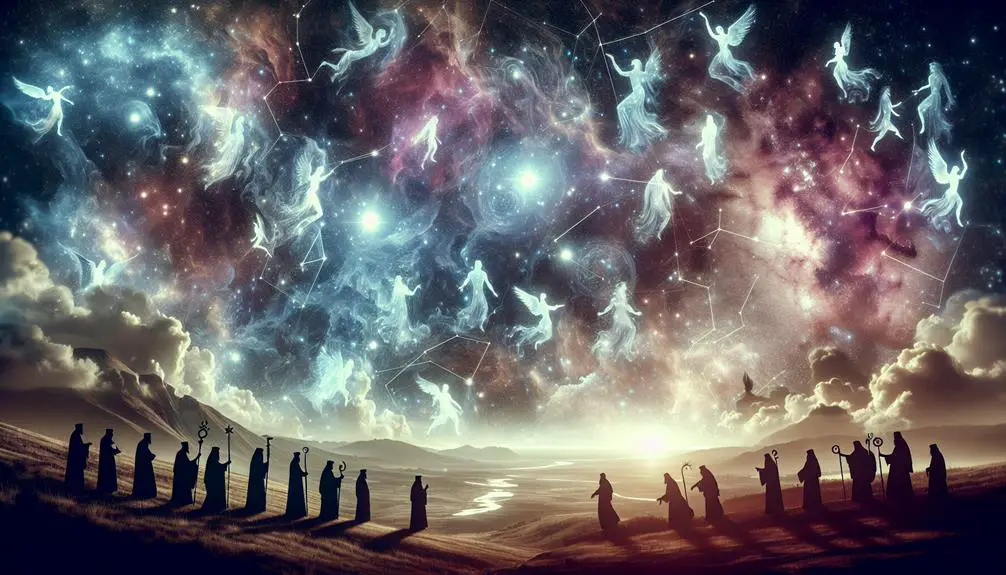
Throughout history, numerous prophets have been said to possess profound connections with celestial or star beings, suggesting a complex tapestry of interactions between the spiritual and the extraterrestrial. This intricate weave of relationships has been documented and interpreted through various lenses, leading to an array of space myths and cultural interpretations that continue to fascinate and perplex scholars and believers alike.
The narratives surrounding prophets and their encounters with star beings often reflect a society's understanding of the cosmos and its attempts to explain the unexplainable. These stories, steeped in the mystical, serve not only as spiritual guidance but also as a reflection of humanity's perennial quest to comprehend its place in the universe. Space myths, in particular, embody the collective imagination of civilizations, encapsulating their fears, hopes, and aspirations.
Cultural interpretations of these encounters vary widely, with some cultures venerating these prophets as divine messengers or intermediaries between the human and the celestial realms. Others view them with skepticism, attributing their experiences to metaphorical or allegorical expressions of spiritual enlightenment or moral teaching. Regardless of the perspective, the enduring fascination with prophets and star beings underscores a universal desire to connect with something greater than oneself, to explore the boundaries of human experience, and to question the nature of existence itself.
In analyzing these ancient narratives, scholars adopt an open-minded approach, recognizing the limitations of contemporary understanding while appreciating the rich tapestry of human belief and experience. This scholarly endeavor not only sheds light on the past but also informs present-day discussions about spirituality, extraterrestrial life, and the interconnectedness of all beings.
Modern Interpretations and Debates
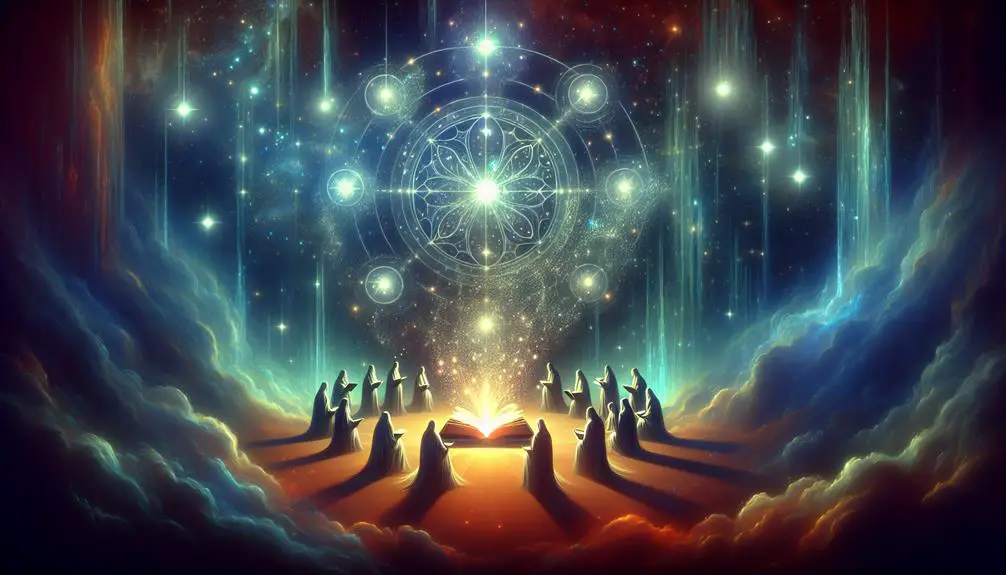
In recent years, the dialogue surrounding the interpretation of prophets and star beings has evolved, sparking vigorous debates among scholars, theologians, and enthusiasts. This discourse has taken a particularly fascinating turn with the examination of Pleiadians in biblical texts. The modern interpretations and debates pivot on several key issues:
- Cultural Impacts: How contemporary interpretations of Pleiadians in biblical texts reflect or influence current cultural and spiritual beliefs. This includes the resurgence of interest in ancient astronaut theories and how these perspectives are reshaped by new age ideologies.
- Historical Accuracy: The challenge of distinguishing between metaphorical language in ancient texts and what might be evidence of extraterrestrial contact. Scholars meticulously analyze historical contexts, languages, and archaeological findings to discern the intentions of biblical authors.
- Theological Relevance: The implications of integrating the idea of Pleiadians or other star beings into traditional religious doctrines. This encompasses discussions on the compatibility of such interpretations with established theological teachings and the potential for expanding the understanding of divine interaction.
- Scientific Perspectives: The intersection between spiritual beliefs about Pleiadians and the scientific search for extraterrestrial life. This includes debates over the credibility of interpreting ancient texts as historical accounts of alien visitation versus understanding these texts as purely symbolic or allegorical.
These debates are not only about reconciling ancient texts with modern beliefs but also about the broader implications for cultural identity, spirituality, and our understanding of the universe. They challenge us to consider the boundaries of historical accuracy and the limitless possibilities of cultural interpretation.
Frequently Asked Questions
How Do Religious Leaders From Various Faiths Interpret the Idea of Pleiadians Being Mentioned or Alluded to in the Bible?
Religious leaders from diverse faith backgrounds approach the notion of extraterrestrial beings, such as the Pleiadians, being referenced in sacred texts with varying degrees of openness. When considering Pleiadian prophecies and Biblical symbolism, interpretations range widely.
Some view these allusions as metaphorical, emphasizing spiritual rather than literal truths, while others entertain the possibility of ancient texts encoding encounters with advanced beings, urging a more open-minded and analytical exploration of scripture.
Are There Any Historical Documents or Texts, Outside of the Bible and the Book of Enoch, That Suggest a Connection Between Pleiadians and Ancient Earth Civilizations?
Exploring the possibility of a historical link between Pleiadians and ancient Earth civilizations necessitates an examination of ancient artifacts and cultural interpretations.
While mainstream historical documents do not explicitly reference such connections, various ancient texts and artifacts, when analyzed through an open-minded, scholarly lens, may offer indirect clues.
These artifacts, coupled with cultural narratives from different civilizations, provide a framework for speculative analysis about potential extraterrestrial influences on ancient human societies.
How Do Contemporary Ufologists and Extraterrestrial Researchers Reconcile Their Beliefs About Pleiadians With Traditional Biblical Narratives?
Contemporary ufologists and extraterrestrial researchers weave a tapestry that blends alien genetics and spiritual technology into traditional narratives, seeking harmony rather than discord.
Analyzing these elements with scholarly rigor and an open mind, they propose that Pleiadians, with their advanced knowledge, have subtly influenced human evolution and spirituality.
This synthesis challenges orthodox views but encourages a broader understanding of our place in the cosmos, bridging the ancient with the extraterrestrial.
What Role Do Pleiadians Play in the Broader Context of World Mythology, and How Does This Compare to Their Depiction in Biblical Texts?
In the broader context of world mythology, Pleiadian myths often depict these entities as benevolent star beings, guiding humanity towards enlightenment and progress. This portrayal diverges from traditional biblical narratives, where direct references to extraterrestrial entities are absent.
The juxtaposition of Pleiadian benevolence in global mythologies against their absence in biblical texts invites a nuanced analysis of their symbolic significance across different cultures and spiritual traditions, fostering an open-minded, scholarly exploration of ancient myths and modern interpretations.
How Have Perceptions of Pleiadians in the Context of the Bible Changed Over Time, Especially With Advancements in Technology and Space Exploration?
Perceptions of extraterrestrial entities have evolved significantly, with 60% of Americans now open to the possibility of alien life. This shift influences interpretations of ancient texts, including those related to Pleiadians.
Advances in technology and space exploration have reinvigorated discussions around ancient astronauts, leading to more technological interpretations of historical accounts. Analyzing these narratives through a contemporary lens allows for a nuanced understanding of their origins and implications within religious and mythological contexts.
Conclusion
In conclusion, the exploration of Pleiadian references within biblical texts, through the lens of Ancient Astronaut Theory and theological analysis, yields a fascinating intersection of spirituality and extraterrestrial hypothesis.
By examining scriptural passages, the Book of Enoch, and prophetic narratives with an open-minded, analytical approach, one uncovers a rich tapestry of cosmic interaction that blurs the lines between celestial beings and divine messengers.
This scholarly endeavor not only enriches the discourse on ancient texts but also expands the horizons of our cosmic understanding.

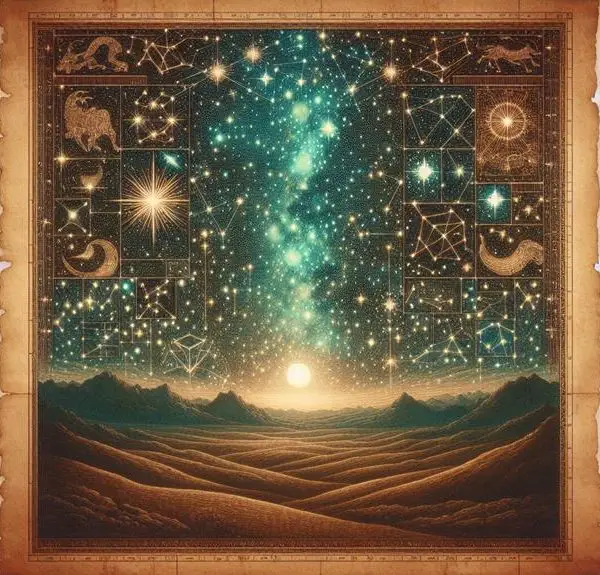
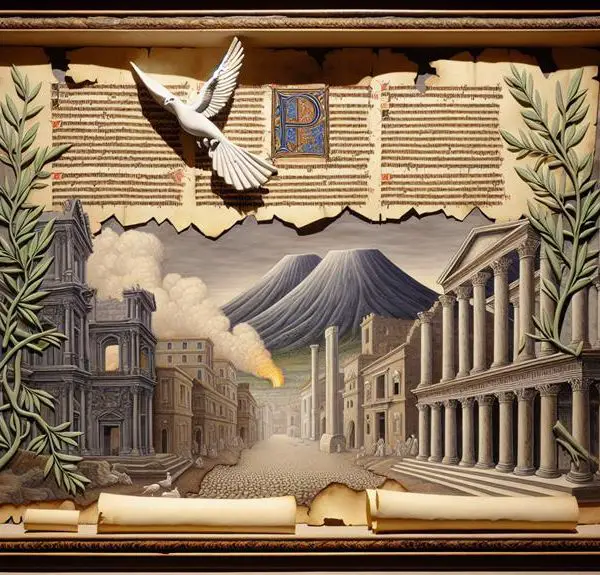
Sign up